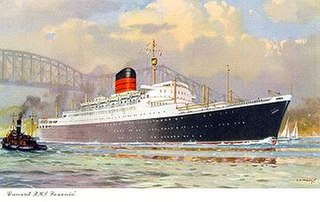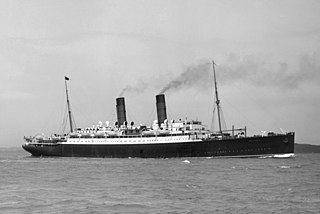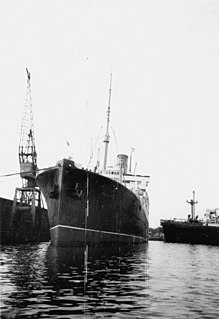Queen Victoria has been the name of several ships:
Two ocean liners of the Cunard Line have been named RMS Mauretania, after the ancient territory of Mauretania:

SS Imperator was a German ocean liner built for the Hamburg America Line, launched in 1912. At the time of her completion in June 1913, he was the largest passenger ship in the world by gross tonnage, surpassing the new White Star liner Olympic.
Franconia is a historical region of southern Germany.
Several ships have been named Niagara. They include:
RMS Carmania may refer to the following ocean liners:

RMS Antonia and her sister ship Andania were the first two of the six 14,000 ton "A" ocean liners built for Cunard in the early 1920s.

RMS Saxonia was a British passenger liner built by John Brown & Company at Clydebank, Scotland for the Cunard Steamship Company for their Liverpool-Montreal service. She was the first of four almost identical sister ships built by Browns between 1954 and 1957 for UK-Montreal service. The first two of these ships, Saxonia and Ivernia were extensively rebuilt in 1962/3 as dual purpose liner/cruise ships. They were renamed Carmania and Franconia respectively and painted in the same green cruising livery as the Caronia. Carmania continued transatlantic crossings and cruises until September 1967 when she closed out Cunard's Montreal service. She and her sister had been painted white at the end of 1966 and from 1968 Carmania sailed as a full time cruise ship until withdrawal after arriving at Southampton on 31 October 1971. In August 1973 she was bought by the Soviet Union-based Black Sea Shipping Company and renamed SS Leonid Sobinov. The ship was scrapped in 1999.
The following ships are named Queen Mary:
Three ships have borne the name Empress of Australia:

A four-funnel liner, also known as a four-stacker is an ocean liner with four funnels.
Caronia is a town in Italy.

RMS Ivernia was a Saxonia class ocean liner, built in 1955 by John Brown & Company in Clydebank, Scotland for Cunard Line, for their transatlantic passenger service between the UK and Canada. In 1963 she was rebuilt as a cruise ship and renamed RMS Franconia, after the famous pre-war liner RMS Franconia. She continued to sail for Cunard until being withdrawn from service and laid up in 1971. In 1973 she was sold to the Soviet Union's Far Eastern Shipping Company and, renamed SS Fedor Shalyapin, cruised around Australia and the far East. In 1980 she was transferred to the Black Sea Shipping Company fleet, and for a time returned to cruising in the Mediterranean and around Europe. In 1989 she was transferred again, to the Odessa Cruise Company, and continued her career as a cruise ship until 1994. She was then laid up at Illichivsk, a Black Sea port 40 km southwest of Odessa, until 2004 when, as the Salona, she sailed to Alang, India, where she was scrapped.

The RMS Franconia was an ocean liner operated by the Cunard Line. She was launched on 23 July 1910 at the Swan, Hunter & Wigham Richardson Wallsend shipyard. Franconia was intended for the line's Boston service, being the largest ship of the time to enter Boston harbor, with winter service in the New York-Mediterranean cruising service.

The RMS Franconia was an ocean liner operated by the Cunard Line from 1922 to 1956. She was second of three liners named Franconia which served the Cunard Line, the others being RMS Franconia built in 1910 and the third Franconia in 1963.
A number of ships have been named Laconia

The first RMS Saxonia was a passenger ship of the British Cunard Line. Between 1900 and 1925, Saxonia operated on North Atlantic and Mediterranean passenger routes, and she saw military service during World War I (1914–1918).

Sir James Gordon Partridge Bisset, CBE, RD was a British merchant sea captain who served as Commodore of the Cunard White Star Line (1944–47). He documented his fifty-year sea career in a three volume autobiography: Sail Ho! My Early Years at Sea (1958); Tramps and Ladies – My Early Years in Steamers (1959) and Commodore – War, Peace and Big Ships (1961). In addition, Bisset authored Lifeboat Efficiency (1924) which became the primary text used by the British Merchant Marine until the Second World War for instructing merchant seaman in lifeboat utilization and handling, and Ship Ahoy ! : Nautical Notes for Ocean Travellers (c.1930), a treatise on shipboard operations for the edification of passengers. He served in or commanded Cunard liners including Carpathia, Caronia, Franconia, Mauretania, Aquitania, Berengaria, Queen Mary and Queen Elizabeth.

RMS Samaria was a transatlantic ocean liner built for Cunard Line. She was completed in 1922 and served until 1955. During the Second World War she was a troopship in the Royal Navy. Samaria was scrapped in 1956.
This page is based on this
Wikipedia article Text is available under the
CC BY-SA 4.0 license; additional terms may apply.
Images, videos and audio are available under their respective licenses.









